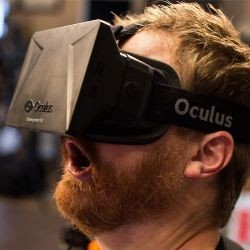Virtual Reality and the Future of Casino Gambling

When casinos began to open online gambling sites during the first decade of the new millennium, many people marveled at the idea of being able to play blackjack, roulette, poker and even slot machines from the comfort of their own homes. The rise of smartphones and tablets changed gambling again, and now it’s possible to spin the roulette wheel while you’re waiting at the airport, or sit down at a virtual poker table on a lunch break, or throw craps while you’re waiting in the reception area for the doctor to see you. But iGaming isn’t finished evolving; we’re already getting a glimpse of what’s next in the world of digital gaming, and it’s something truly unbelievable.
Virtual Realities
During the 1980s and 1990s, there were several science fiction movies featuring virtual reality headsets in which people found themselves plunged into realistic three-dimensional artificial worlds that seemed incredibly real. It seems we’re on the verge of such fictitious scenarios now becoming reality, at least from a technological standpoint. The company Oculus Rift has already introduced virtual reality headsets that allow people to play games in three-dimensional spaces, and while these units are currently very expensive, like all technology, they’re sure to come down in price as competitors emerge.
What’s Possible with VR?
As virtual reality headsets become more mainstream, the world of iGaming will be able to take on a whole new level of reality. With a VR headset, it could one day be possible to actually visit world class casinos in Las Vegas, Monte Carlo and other notable destinations without ever leaving your sofa. Players will be able to actually see real tables and slot machines when they sit down to play, and competitors will look like real people, not avatars on the screen. It’s even possible that video type games of skill could be added to the fun, allowing players to complete tasks like shooting bad guys for more money.
As Mark McGuinness, the Director of eSports Digital Betting & Gaming, explains: “Gaming is about the emotional and physiological experience of playing at the casino tables, and all the sensory stimuli that this delivers. VR could replicate that experience of walking into the casino lobby, being greeted by the hostess, and being led to the gaming floor. It really could replicate the physical gaming experience to a whole new level, while breaking down consumer barriers in order to potentially drive patrons into a land-based casino that have perhaps never ever set foot in one.”
How VR Could Help the Industry
While online gambling providers will obviously have to invest money and time in research and development to enter the virtual reality era, it’s likely that the money will be well spent. VR environments are likely to encourage players who were otherwise hesitant to try online gambling to play. With a virtual reality headset, it will be possible to be an observer, watching and learning from others to build confidence before wagering. Plus, the fun and excitement of playing in a realistic casino environment could be enough to prompt new millennial players to head through the doors of land-based casinos that are currently struggling to attract people in this key age demographic.
Conclusion
If all of these potential uses of virtual reality sound impossible, it should be noted that at this time, the future of VR iGaming is all speculation, but the time when we might see it in practice is closer than you probably think. Experts believe that in as little as 10 years, virtual reality casino gaming may be readily accessible to players all over the world, meaning big changes for the online gaming industry.
In the meantime, the ICE Totally Gaming 2016 conference was held in London in February, and while casino operators were seeking out new products to attract customers, one particular company, Microgaming, opened up a whole new world of future possibilities with its innovative VR Roulette game. As Neil White, Head of Product Channels at Microgaming, later commented:
“We were the first to embrace the mobile revolution. We are now predicting that next is Virtual Reality and we are going to make sure that we will be part of that wave. We have also experimented with Augmented Reality and we have seen how that can be used for marketing and promotions, as well as turning some land-based scratch card products into online products that can be used on wearables.”









